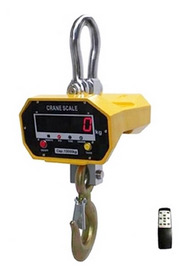How to Calibrate a Digital Crane Scale?
Due to its simple structure, the digital crane scale doesn't need to be installed in a fixed place, and is convenient for moveable weighing. It is widely used in docks, steel and other industries. Just hang the cargo on the hook of the digital crane scale, lift the hook scale and cargo off the ground by lifting equipment. The weight of the cargo can be quickly measured according to the principle of gravity. Due to the structural limitations of crane scales, there are usually a tension load cell, a display meter and transmitting & receiving devices. The digital crane scale has rich functions and can remotely operate and receive measuring data.
For the digital crane scale, in order not to affect its weighing result, it is required to calibrate it regularly. After investigation, many customers either neglect to calibrate the digital crane scale or have the incorrect calibration method. Now let's introduce you how to calibrate the digital crane scale correctly.
After installation, check whether all parts of the digital crane scale are intact. The crane scale body should not contact any part of the foundation, and the space between the scale body and the protection iron casing must be 10mm ~ 15mm.
Before debugging, the power switch should be turned on at first to warm up digital crane scale for 15 minutes.
The calibration method is generally the same as that of the electronic truck scale, the only difference is in the eccentric load calibration.
- First, the appearance inspection is performed. The inspection items include the maximum capacity, minimum weight, and graduation value.
- After the visual inspection is completed, it is necessary to pay attention to the weighing test.
For the crane scale with a maximum capacity of less than 5 ton, the weights used for calibration should be as flat as possible. Easy-to-stack weights make lifting easier and increase safety.
For the crane scale with a maximum capacity greater than 5 ton, it is difficult to safely lift so many weights with wire rope. This requires making a lifting platform so that the weights can be safely and stably placed on the lifting platform. The crane scale directly connects with the platform for calibration.
Because the digital crane scale needs to use a wire rope for hoisting standard weights, hang the wire rope on the hook before lifting the weight. After lifting off the ground, press the tare key to remove the weight of the wire rope. The wire rope doesn't need to be too long, so as to avoid shaking for a long time after lifting the standard weights and cause the data unstable. However it must be ensured that the standard weights equal to maximum capacity can be safely lifted. - It is different from other electronic scales when doing eccentric load calibration. Crane scale eccentric load calibration requires the standard weights equal to 80% of the maximum capacity. The eccentric load point should be detected: After hanging the standard weights under the hook, first rotate 360 degrees clockwise and record each eccentric load value at the 90/180/270/360 degrees , and then rotate 360 degrees counterclockwise and record each eccentric load value at the 90/180/270/360 degrees. So there are 8 detecting points of eccentric load.
- Other testing items such as resolution, tare and repeatability are consistent with the electronic truck scale calibration methods.

